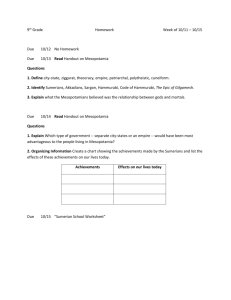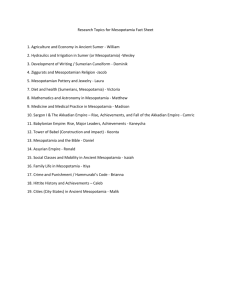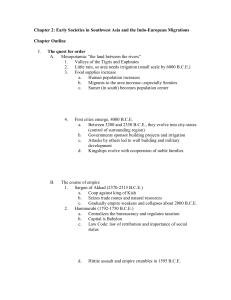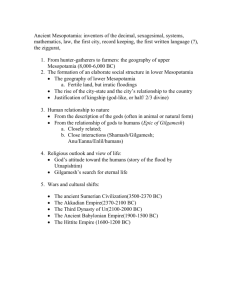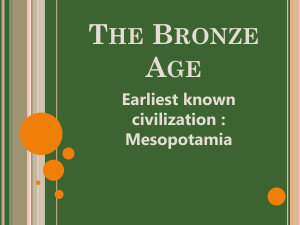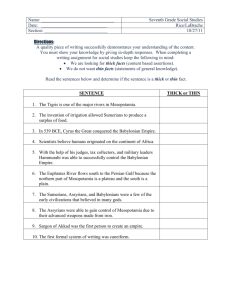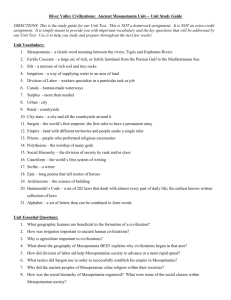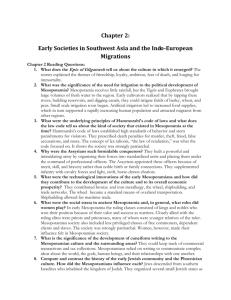Mesopotamian Society
advertisement
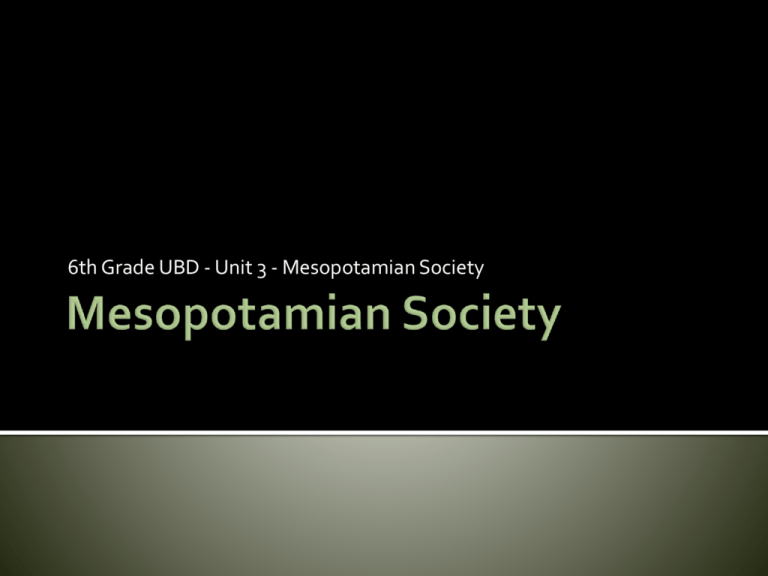
6th Grade UBD - Unit 3 - Mesopotamian Society Mesopotamian Religion- Mesopotamians were polytheists. They worshiped many different gods connected to nature and to particular aspects of life. A Social Pyramid- Mesopotamian society was organized into a social pyramid. Your place on the pyramid was determined by your work. Most people stayed at the level they were born at for their entire lives. A Series of Conquests- Mesopotamia was a rich land that many people sought to conquer. In Mesopotamian society people had many different roles. This created a vibrant civilization. How does religion and gender influence life today? (5 minutes) Work with a neighbor and compare your answer with theirs. What things are the same and what things are different? (3 minutes) Mesopotamia was one of the earliest civilizations to have an organized religion. Their religion helped to shape their society and culture. Mesopotamian city-states built ziggurats to worship their gods. Mesopotamians believed that their kings were chosen by the gods. Religion played an important role in the daily life of ancient Mesopotamians. The Mesopotamians believed in polytheism. Each god or goddess was in charge of a part of nature or daily life. The Mesopotamians wanted to honor their gods and goddesses and make sure they stayed in the city. So the people built large religious monuments called ziggurats. To keep the gods and goddesses happy, Mesopotamians left offerings, or gifts, for them. The gifts also were given to ask the gods to send blessings. Key Term Civilization- A ancient religious structure built in the major cities of Mesopotamia that are similar to the pyramids. Reading Handout- Mesopotamian Ziggurats People from all levels of Mesopotamian society were important to the success of the civilization, but different groups had different amounts of power. The king was the most important political and religious figure. Enslaved people were at the bottom of the social pyramid. They had no power. Key Term Social Pyramid- A way of illustrating the social organization of a particular society. The people with the most wealth are at the top. The people with the least money and the lowest social position are on the bottom. There are several marks of civilization. One of them is that work is specialized. Everyone contributes in some way to help meet society’s needs, but people do not have to do everything for themselves. Mesopotamian kings held a great deal of political and religious power. They determined the laws, collected taxes, and organized labor for large projects such as digging irrigation ditches. Mesopotamian people viewed their kings as conduits to their gods, so kings were also responsible for religious ceremonies. Religion gave kings the authority to rule, and in return kings fulfilled religious obligations. Mesopotamia developed a stratified social-class society. A person’s work determined his or her place in Mesopotamian society. The higher social levels had the fewest people. The king, priests, and other important leaders made up the top tier of Mesopotamian society. Scribes and other merchants were a step below the top tier, and peasants and slaves were found at the bottom layer of the social pyramid. Artisans specialized in making various goods. Mesopotamia had bakers, iron workers, potters, and weavers. Video- How It's Made Bread Scribes were also important members of society. They were the record keepers. They spent years learning to read and write cuneiform, the writing system used in Mesopotamia. Key Term Cuneiform- A system of writing that was widely used in the ancient Middle East. Peasants farmed the land surrounding the cities. They sold their extra food to people living in the cities. Farmers also gave a certain amount of their crops to the king. In all social classes, men held more rights and responsibilities than women. Most of Mesopotamia’s religious and political leaders were men. In addition, men made household decisions. Men decided everything from what work would be done to whom their children would marry. Women had little power in Mesopotamian society, although they were granted some rights. Women’s roles in society were those of daughter, wife, or mother. Women usually did not learn to read or write. Instead, mothers taught their girls how to be good wives and mothers. Reading Handout- Mesopotamian Women Mesopotamia many natural resources made it a good place to live. It was also a valuable land for leaders to conquer and rule. The history of Mesopotamia is marked by four great empires. Between each empire’s rule and the next, there were moments of disorder before another leader conquered the region. Mesopotamia was conquered by many empires, from the Akkadians all the way through the Neo-Babylonians. Mesopotamia was a valuable land for conquerors due to its rich land and well-traveled trade routes. The Akkadian Empire was the first major empire in Mesopotamia. Sargon was the first king of the Akkadian Empire. The Babylonian Empire conquered much of Mesopotamia after the fall of the Akkadian Empire. The Assyrian Empire was the largest of the four empires. The Assyrians conquered other lands easily, but they had difficulty controlling their vast empire. The Neo-Babylonian Empire, replaced the Assyrian Empire. Although it was not as large as the Assyrian Empire it was very powerful. Because Mesopotamia had rich agricultural land and a lively culture, many different empires conquered it. Each empire had an effect on the culture of Mesopotamia while also adopting certain parts of Mesopotamian culture. What has been the “muddiest” point so far in this lesson? That is, what topic remains the least clear to you? (4 minutes) Work with a neighbor and compare your muddiest point with theirs. Compare what things are the same and what things are different? (3 minutes)
